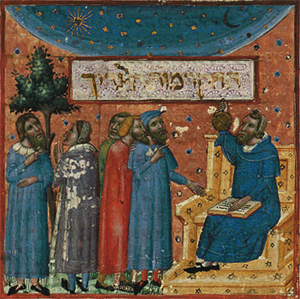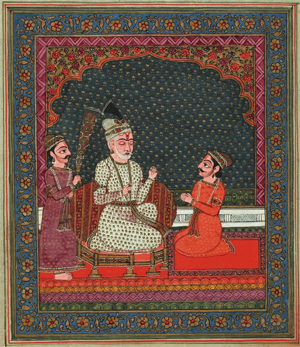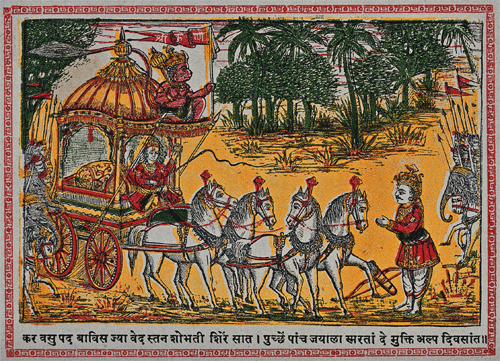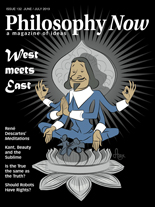West Meets East
Truth and the True
Joseph Sen on types of knowledge in Western and Indian thought.
“…when he is in doubt about anything, or unable to find a proof for the object of his inquiry, he must not at once abandon, reject and deny it; he must modestly keep back, and from regard to the honour of his Creator, hesitate [from uttering an opinion] and pause.”
(Maimonides, The Guide for the Perplexed, trans. M. Friedlander, p.43)
Is there a difference between the true and the truth? Facts, we might say, are true but is truth itself a fact we have in our hands or an ideal we seek without guarantee of possession?
We speak about the truth of a situation, the truth about things, the truth about persons, about life. But do we ever have full knowledge of any of these? If truth involves full knowledge we would have to say that we don’t. In any situation there is always something unknown, something hidden and undetermined. Perhaps this sounds obvious; but our use of the term ‘truth’ to describe the knowledge we have is liable to make us think that this knowledge is final, conclusive – that all that is to be known is known. (“That’s how it is!”)
We have a tendency to identify the true (facts) with truth (an ideal). What we know to be true are facts taken individually. Cumulatively, we may assume that these make up the “truth”. But they certainly do not if by truth we mean conclusive, unsurpassable knowledge, subject neither to revision nor expansion. But this tendency to identify the true with the truth can create problems.

Maimonides guides some of the perplexed.
An old friend says farewell through a mutual acquaintance.
“She told me to say goodbye to you …”
On hearing this we may think that this fact represents the truth about the situation. Our friend said goodbye to us through someone else, a third party. And all she said was ‘goodbye’! If we’re not careful we will take the true here for the truth. The truth of this situation then becomes “Our friend said goodbye to us through a third party.” Our jumpiness may then lead us to conclude that our friend didn’t care too much about us after all.
Our tendency to identify the true with the truth here can block understanding. The assumption that the truth has been said imputes a full-stop to what may only require a pause. What I mean is that there is a lot more to the situation than what is given at first sight. Not everything has been said about the situation, there may be more facts than meet the eye. But if we identify the facts we have been given with the truth we will stop short of further enquiry. If we pause though, to ponder what has been said, we may realise there is more to be said and we may ask further questions:
“How did she say it?”
“Under what circumstances did she say it? For example, did she take you aside to tell you? Or did she say it in the middle of a group of friends?”
“What expression was on her face?”
Such questions allows us to fathom more about the situation by gathering facts which we deny ourselves as soon as we take the first statement to be identical with the truth. We would then see that the first fact by itself in no way represents ‘the truth’ of the situation but only something true about it.

Sanjaya gives the blind king Dhrtarastra the facts from the battlefield upon which the Bhagavad Gita unfolds.
The story of the Bhagvadgita. Wellcome Collection. CC by 4.0
Could these further questions then bring us to the ultimate truth of the situation? Probably not. The full truth remains an ideal for us. What we could say is that the extra questions we ask and the additional facts they yield bring us nearer to this ideal and take us further away from untruth, which would here involve an inadequate or one-sided picture of things.
Closeness to the truth is here related to the extent of our questions. For our questions here determine which facts a situation yields. In our example, not questioning left us with only one fact about the situation, which by itself gave only a vague picture of it. Our inability to pause prevented us from moving nearer to the ideal. We mistook the true for the truth.
In Meditation IV, René Descartes wrote about the origin of error. We make errors not because of our intellect but because of our will. We see the Sun as a round disk and conclude it is actually a round disk. But this needn’t happen. The fact that the Sun appears as a round disk to us needn’t compel us to assert that it is so. This judgment is made by an effort of the will; we take one fact and identify it with the truth. But this is due to hastiness.
Hastiness goes with an inability to question. We judge too quickly. Truth requires a kind of patience, an ability to open up to the possibility that what we have now is not final. We cannot rush truth but must wait for it to unfurl and who knows the limit to which it will reach in its unfurling? This unfurling may take a lot of time to happen and so we need patience.
Truth tends to be linked with judgment. But perhaps truth might be more closely related to understanding. That is to say, if our aim is to understand rather than judge we may be less hasty in making assertions about the truth on the basis of a few facts we have at hand and be more prepared to wait, to suspend judgment in the awareness that there may be more facts to come which will bring us closer to the ideal of truth. We can contribute to discovering these facts by pausing in the face of the facts we have so far gathered in order to ask more questions.
On this approach we gather facts not to make a judgment but to understand. And understanding is something we can always gain more of. We may get enough of judgment but not of understanding. Understanding is inexhaustible. It leaves a space for more facts to come and take us nearer to the ideal of truth.
Choosing to seek greater understanding rather than rushing to judgment enables us to do justice to the many-sidedness of a complex situation. Our mind takes the shape of the situation instead of forcing it into a preconceived mould. We are ready for more; we have not locked ourselves into a position which is static, and from which new facts appear like assaults upon our intellect.
The word ‘factor’ here becomes significant. When we speak of factors we do so non-finally whereas the term ‘fact’ has more of a hard-edged ring about it. It is more conclusive and exclusive. The notion of a factor leaves more space. Factors do not claim to capture a situation, only to illuminate it. Factors always aspire to being facts. On the other hand, facts are factors which have forgotten themselves.
We get nearer the truth by seeing a situation from as many perspectives as possible. The more perspectives we can gain, the more our tendency moves away from judgment to understanding.
Consider an example. Why do other people sometimes seem to be less free than we ourselves are? Maybe this perception is the source of a lot of problems as it can tie in with seeing others as more like objects than we take ourselves to be. It may require an effort but we can imagine other people as equally free. This involves understanding a perspective other than the one we may be immediately given.
Truth may be an ideal which we never reach once and for all, but we can certainly gain a richer approximation to it through this openness to plurality. And the more facts we grasp about a situation, the more careful we will be about the assertions we make. This is contrary to the view that ignorance alone can guarantee non-judgmentality. The more eyes we have, the more understanding we gain and the less judgmental we become. And we gain more eyes through questioning. The fact that I’ve never seen a Number 7 bus go to Russell Square doesn’t mean there is no Number 7 bus that goes to Russell Square. If I keep my eyes open and don’t jump to conclusions I may yet spot such a bus one day.
It might be asked whether all facts are the same? Moreover, what if there are no facts ‘out there’ at all, only interpretations? It should be said here that we mustn’t allow understanding to be so excessive and so passive as to rule out goodness. Some facts may be better than others. The fact that a mother loves her child is simply not of the same kind as the fact that a sadist is frying a kitten in a microwave. The former deserves understanding while the latter requires us to pronounce judgment without hesitation. We must here even go as far as to impose a limit on our understanding rather than wait for our understanding to limit itself. Even if all facts are nothing but interpretations we must still decide which among the countless interpretations is best. After all, we are willing, not just thinking and feeling, beings. We should choose the interpretation which brings the most love and goodness.
In the ancient Hindu scripture the Bhagavad Gita, three kinds of knowledge are outlined which express a theory of the three qualities of nature. These qualities are sattva (goodness), rajas (energy) and tamas (inertia). The first kind of knowledge is described in the following terms:
“That knowledge by which one sees
One imperishable Being in all beings,
Undivided in separate beings;
Know that knowledge to be sattvic.”
(Bhagavad Gita XVIII.20, trans. W. Sargeant)
The highest kind of knowledge involves a deep sense of the unity of life. What makes this kind of knowledge good? The case of the mother loving the child shows the presence of unity and interconnection, a condition which is far from being morally evil or even neutral. Knowledge of unity recognises the absolute value of such situations and does not put them on a par with ones characterised by division or aggression.
Hegel describes something akin to this first kind of knowledge with his idea of ‘the concrete universal’, a universal idea running through its individual instances which is best exemplified by God, the Absolute, who is infinite and finite at once:
“It may also be said in this strain that the absolute idea is the universal, but the universal not merely as an abstract form to which the particular content is a stranger, but as the absolute form into which all the categories, the whole fullness of the content it has given being to, have retired. The absolute idea may in this respect be compared to the old man who utters the same creed as the child, but for whom it is pregnant with the significance of a lifetime.”
(Hegel, Logic, trans. W. Wallace 237)
Here is an account of the second kind of knowledge:
“But that knowledge which sees
In all beings
Separate entities of various kinds,
by differentiation,
Know that knowledge to be rajasic.”
(Bhagavad Gita XVIII.21)
Philosophers like Jacques Derrida who emphasise the role of difference in language provide a case in point, as does the thirteenth century Indian philosopher Madhvacharya, who speaks of the ‘fivefold difference’ – between God and individual souls, individual souls themselves, God and matter, individual souls and matter and between pieces of matter. David Loy construes all everyday conceptual knowledge from this perspective for two reasons. Firstly, in this knowledge a subject knows an object apart from itself. Secondly, this object is understood in distinction from other objects:
“… such knowledge must discriminate one thing from another in order to assert some attribute about some thing.”
(David Loy, Nonduality: A Study in Comparative Philosophy Yale Univ. Press, 1988)
What of the third kind of knowledge?
“That (knowledge), however, which is
attached to one single effect
As if it were all, and without reason,
Without reason and small in
significance,
Is declared to be tamasic”
(Bhagavad Gita XVIII.22)
This suggests that knowledge is not confined to the general but can be something particular. The third kind of knowledge involves narrowing the focus of attention down to one thing to the exclusion of the wider environment in which it is really situated and not connecting it to a greater field of unity. Removing a piece of fluff from my coat is an example. Isolated matters of fact also exemplify this. So does the sad case of the kitten in the microwave, whose murderer thinks only of his own pleasure to the exclusion of the first, higher knowledge which involves a strong sense of relatedness to the kitten’s life.

In the Bhagavad Gita, things get philosophical when Prince Arjuna asks Krishna, his charioteer, for advice before the onset of war.
A scene from the Mahabharata. Wellcome Collection. CC by 4.0
This essay is an everyday example which shows how all three kinds of knowledge can come together. In writing it I have a guiding theme or idea summed up in the title ‘Truth and the True’ (the first knowledge) which is expressed in many different words (the second knowledge) written or read one at a time (the third kind of knowledge). This example shows that the three kinds of knowledge need not be seen in terms of a moral hierarchy.
The Bhagavad Gita’s three kinds of knowledge, however, relate to the qualities of nature, the gunas, which are the elements of the material universe. They are mentioned within a wider context which discusses another kind of knowledge altogether – that of pure unity:
“It is axiomatic in the yoga tradition that ‘knowledge is different in different states of consciousness’ (Rig Veda). In other words, our level of consciousness completely determines how much truth we see of any given situation. The clearer our minds, the more correctly we evaluate our experience. The state of Enlightenment is said to be complete knowledge, because it is based on the unchanging experience of the Knower – the Self. Until this state is reached, any knowledge is ultimately baseless, because it depends only on the mind, which is a prey to passing moods and general instability.”
(Alistair Shearer, The Yoga Sutras of Patanjali, pp.41-42)
This is an experience of nonduality beyond every kind of differentiation. Does this experience show that the ideal of truth can be realized once and for all? Is enlightenment a static condition or is even enlightenment a condition from which more and more growth is possible?
“For the Perfect the drama of life is ended: nothing can be done any more, no decision can be taken any more, for decisions belong to the condition of man to whom both knowledge and ignorance are given and who can have an hypothetical knowledge of the future, knowing that on his decisions the future may depend and to whom a sure knowledge of the future is denied. But an Omniscient Being can neither act nor decide; for him the future is irremediable like the past and cannot be changed any more by His decisions or actions. Paradoxically the Omnipotent is impotent.”
(Averroes, The Incoherence of the Incoherence)
According to Hegel the true infinite includes the finite, the perfect includes the imperfect. For God to be complete He must partake of the incomplete, otherwise there is something left outside Him which would make Him incomplete anyway. His completeness either consciously embraces incompleteness or He is unconsciously incomplete. The first view is compatible with omniscience, the second denies it. Maybe in God there are two kinds of perfection: perfect perfection and imperfect perfection.
Surely God, being perfect, has the richest life and this entails a future. But maybe he is omniscient about the general drift of the future; maybe he knows, for example, that it will be good without needing full knowledge of every detail of it. Mystery should not be the general rule but something found only in the small print. Likewise the presence of a good God ensures a good future for everyone without this entailing that God will determine this future in every detail for other beings.
According to Professor Richard Sorabji in his 1983 book Time, Creation and the Continuum, Gregory of Nyssa “viewed mystical experience of God, not as something static, but as a perpetual discovery. Since the distance between the soul and God is infinite, there will always be more to understand, and the more we understand, the more we recognise that God is incomprehensible. But we will never feel satiety, because we can always progress.”
However, just because there is endless progress this need not imply the absence of fulfilment at each step of the movement. Maybe there is an ever growing fulfilment as well. In Buddhism, the Bodhisattva continues to develop in his or her enlightenment into a future we can barely conceive.
© Dr Joseph Sen 2019
Joseph Sen took his Philosophy PhD at King’s College London.
• Thanks to Dr Alfons Grieder for his comments on an earlier version of this article.


No comments:
Post a Comment